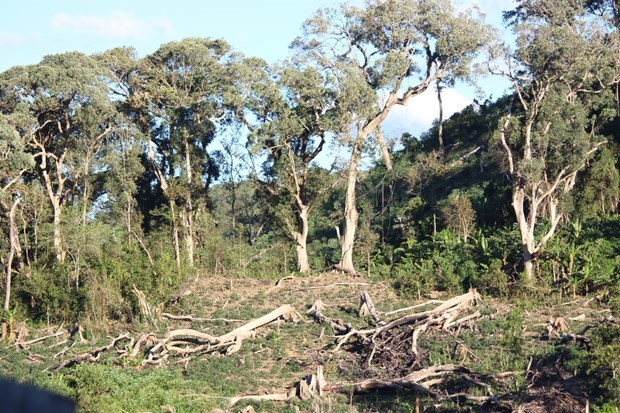Community-based forest management the way forward
 Illustrative image (Photo: VietnamPlus)
Illustrative image (Photo: VietnamPlus)
Hanoi (VNA) – The 2017 Forestry Law, which came into force on January 1, 2019, has expanded the notion of residential communities and acknowledged them as one of the seven groups of forest owners for the first time.
The move aims to promote community-based forest management, towards sustainable protection of natural forests.
Issues regarding forest ownership of communities were discussed at a seminar held by PanNature in Hanoi on January 10.
Recognising communities as forest owners
Statistics released by the Vietnam Administration of Forestry reveal that in 2018, Vietnam had 1,145,601 hectares of forest managed publicly (equivalent to 8 percent of the total coverage), of which natural forests exceeded 1,048,765 ha and man-made forests spanned 96,836 ha. However, only 524,477 ha was approved to be handed over to more than 10,000 communities.
The real area of forest possessed by communities remains limited compared with the forests they are managing and using. Communities in many localities manage even less forest land than those leased to companies, managing boards and businesses.
Regarding the public’s role in forest management, PanNature Deputy Director Nguyen Viet Dung said after the community-based forest management model was piloted nearly two decades ago, communities can now monitor forests effectively, bringing environmental, economic and social benefits.
Community-based forest management has helped reduce forest losses and degradation, revive and develop forests, while generating forest-sourced income for locals, he said.
Dung, however, pointed his finger to the fact that many localities and management agencies have yet to support the handover of land and forest to communities for fear of forest losses.
“The fact that communities engage in forest management but lack ownership, even forests traditionally managed by ethnic minority groups, has caused difficulties for forest management, development and recovery in localities, and posed risks of forest losses and degradation,” Dung said.
To deal with this issue, the 2017 Forestry Law that took effect on January 1, 2019 has recognised residential communities as one of the seven forest owners for the first time. The move aims to promote community-based forest management, towards sustainable protection of natural forests and better livelihoods for the public.
The document prescribes that “the State ensures that ethnic minority groups and residential communities live on forests, and receive forests and land in service of their production” (Clause 6 – Article 4).
However, the problem lies with whether the law can help communities become real forest owners given the State still holds ownership, and what the State should do to ensure systematic and professional community-based forest management.
Experts said communities would lose the chance to possess forests under the regulations, saying that natural forests are a public asset and the State represents the ownership. The Vi Chring community in Hieu commune in the Central Highlands province of Kon Tum is an example. In 2008, the rural community got 808.8 ha of natural forest and was tasked with protecting the forest, using it sustainably and developing forestry products apart from timber.
However, the Government’s announcement to close natural forests in 2010 hindered the community from benefiting from the forest as no agency has approved their exploitation plans. Many households want to turn natural forests into man-made ones to get forest ownership.
 The forest has been handed over to the community in Vi Glong hamlet, Hieu commune, Kon Plong district, Kon Tum province, for protection, but is still being destroyed. (Photo: VietnamPlus)
The forest has been handed over to the community in Vi Glong hamlet, Hieu commune, Kon Plong district, Kon Tum province, for protection, but is still being destroyed. (Photo: VietnamPlus)
Policies needed to help communities gain benefits from forests
To deal with these issues, PanNature suggested major reforms to establish a more suitable and clearer ownership and beneficiary mechanism of natural forests to assist management agencies in forest protection and forest resources improvement.
It is necessary to identify how many out of the 10 million ha of forest are under State ownership and may be transferred to communities or the private sector, it said.
Natural forests in need of being protected should be transformed into protective forests and considered public assets, and the State should focus resources on protection work.
Natural forests that are exhausted or had been exhausted and are being used as production forests should be recognised as assets of individuals or communities. The owners should be allowed to exploit forests in line with regulations.
Dao Xuan Khanh, from the Research Institute for Sustainable Forest Management and Forest Certification, said handing over forests to communities is an important step. He, however, proposed the State roll out suitable policies to support ethnic minority groups and grant forestry land-use right certificates, thus raising public confidence in forest protection and development.
[Forests destroyed in northern Dien Bien province]
At the seminar, the delegates also discussed result-oriented solutions, contributing to completing policies and effectively implementing public forest management in Vietnam.
The State should set forth suitable policies and mechanisms towards village and hamlet communities, and streamline procedures relating to forest land handover to ethnic groups, they said.
Besides, local authorities need to review forest status and demand for forest land of communities to deal with forest overlap, disputes between forest owners and carry out the handover of land and forests to village and hamlet communities.
 The State has been urged to ensure community-based forest management is implemented systematically and professionally. (Photo: VietnamPlus)
The State has been urged to ensure community-based forest management is implemented systematically and professionally. (Photo: VietnamPlus)
The 2017 Forestry Law has identified communities as forest owners. Under the document, forest owners comprise special-use and protective forest management boards; economic organisations – including businesses, cooperatives, unions of cooperatives and other economic organisations that are established and operate in line with law; units under people’s armed forces; organisations of science-technology, training and vocational training on forestry; domestic households and individuals; communities; and foreign-invested businesses that lease land for forestation in service of their production./.













